#monkey king reigns supreme
Explore tagged Tumblr posts
Text

Sketch-like Netflix monkey king fanart.
Just sketches of monkey king and lin.
#multiversa#art#cute#the monkey king#monkey king#monkey king 2023#monkey king headcannon#monkey king netflix#the monkey king netflix#netflix monkey king#monkey king reigns supreme#monkeykingreignssupreme#netflix monkey king 2023#netflix monkey king lin#the monkey king 2023#netflix the monkey king#monkeyking2023#Monkey king#Fanart#monkey king netflix fanart
25 notes
·
View notes
Text

Now that this movie fandom is slowy forming and rooting for the creators, can we use this hashtag?
#MonkeyKingReignsSupreme
#Monkey King Reigns Supreme#the monkey king#monkey king#monkey king 2023#the monkey king 2023#monkey king netflix#sun wukong
113 notes
·
View notes
Text
@craftydreamtree has made a monkey king discord for fans of the monkey king movie from Netflix

Interested ? heres the invite https://discord.gg/UMdQ4EcF
If it doesn’t work ask me or crafty for the invite
23 notes
·
View notes
Text
Imagine if someone texted you about your weird little interest on your sideblog dedicated to said weird little interest
#silliness reigns supreme#what if#what if we talked about our favourite fanfic#and our favourite fanarts#and headcanons#here do you wanna see my blorbo???#*opens terrarium like a weird lizard kid and holds them out like that fucking monkey held out the simba in the lion king*
1 note
·
View note
Note
LMAO
LMK: I lie to keep everyone I love safe
Novel: I will be brutally honest with you
"you look fucking ugly, go change, that outfit ain't matching."
#xiyouji#monkie kid#sun wukong#monkey king#yet another reason why og classic monkey king reigns supreme <3#jttw#addition
74 notes
·
View notes
Text
BIG NEWS!🐒
instagram
THE SCRIPT IS FINISHED!🥳 I can't wait to start animate! But first, I'll need YOUR HELP! Do you like Journey to the West? Do you wanna be a voice actor/actress? Do you wanna have fun and enter in this new story?
I'll update you during these days... Monkey King Reigns Supreme!🐒
#helpwanted #voiceover #voice #voiceacting #voiceactor #voiceactress #castingcall #netflix #netflixthemonkeyking #themonkeyking #themonkeyking2023 #sunwukong #journeytothewest #jttw #bigproject #script #animation #3danimation

#journey to the west#jttw#netflix the monkey king#sun wukong#the monkey king 2023#story#series#please share#coming soon#3d animation#help wanted#casting calls#voiceover#voice acting#voice actress#voiceactor#netflix#scriptwriting#new story#Instagram
19 notes
·
View notes
Note
❛ it’s my fault, isn’t it? ❜
𝐯𝐚𝐫𝐢𝐨𝐮𝐬 𝐪𝐮𝐞𝐬𝐭𝐢𝐨𝐧 𝐬𝐞𝐧𝐭𝐞𝐧𝐜𝐞 𝐬𝐭𝐚𝐫𝐭𝐞𝐫𝐬.
'Sigh....yes.'

'It's not the end of the world, though.'
Wang Yi pats Sun on the head before surveying the damage in the alleyway. There's a bunch of dudes knocked out and quite a bit of blood on the ground, but it looks like everyone's still breathing at least.
Honestly, he should've expected something like this to happen eventually, what with Sun always sporting weird cuts and talking about his fighting skills on and off. Point was: if you hit people too hard, they would come hitting you back.
Of course, if you were Sun, you ended up beating them all half to death before they got a scratch on you. The Monkey King reigns supreme, he guessed.
'Tell you what,' Wang Yi suggests as he drags Sun further away from his mess. 'I'll clean this up for you and you promise to lay low for a few weeks. Like, stop doing whatever shady stuff you did to get targeted by lowlives in the first place, all right? And don't go to the seedier areas of town.'
He should probably do that too, but ehhh that can come later.
It isn't until he makes Sun nods to agree that Wang Yi stalks to the closest man still conscious, lifts him up by the scalp, and stares into his eyes.
'Hi,' Wang Yi starts pleasantly enough as his pupils glow red. 'You just lost your mind and got your subordinates all beaten up. You should probably make sure they remember who's actually responsible.'
The man blinks groggily before he nods. Wang Yi lets go and watches as he starts stumbling towards the other victims, kicking them awake and shouting about how he'd teach them a lesson again if they got smart with him.
Good enough. He couldn't make them forget what happened, but some misdirection here and there could bury the true culprit, probably. He strolls back to Sun and swings an arm over his shoulder, guiding the guy out into the streets as the sounds of fighting continue behind them.
'Anyways, let's go check on your injuries before getting some food. I'm starving.'
3 notes
·
View notes
Text
Unveiling the tips and tricks of being a successful social media manager:

Social Media Manager (SMM)… sounds fun right?
I mean, we all hang around on social media the whole day anyway - posting life updates and sharing around funny, often meaningless, things - why not get paid for it, RIGHT!
WRONG - Being a SMM actually feels a bit more like juggling flaming swords while riding a unicycle…
Hectic… I know… but very close to reality.
Don't get me wrong - social media management does have it's upsides and can be fun and rewarding - but trying to keep up with the ever-changing landscape of social media and keeping your clients happy while doing so, can be hard.

That is why I am writing this blog post - to provide you with the tips and tricks I have learned throughout my journey as a Social Media Manager - tips I've gathered through trail, success and obviously... My errors.
You can call it my purpose in life - making the mistakes, so that you dont have to!
This guide I will assist you to learn how to navigating this thrilling, often chaotic realm with finesse and flair.
So let's dive in, shall we?
What if it is your monkeys, meaning it is in fact your circus?
#1
Well first of all - KEEP CALM AND PLAN!
Planning is my secret weapon and I have used it to slay many "dragons" before.
I rely on planning so much that I've actually recently started sharing my planning techniques and planner layouts on my brand new online store named "BiteMagic" (if you are into digital downloads and planning) You can check out my variety of industry specific planner layouts, as well as a category made specially for al my boss ladies out there (yeah girl... We see you 😉) in store by clicking on the link below 👇
https://bitemagic.etsy.com

Planning brings us peace - because we know what to expect when we have planned our steps and therefore we can RELAX knowing that whatever happens, we've got a plan for it!
#2
Content is King (Or Queen...!)
In the kingdom of social media, content reigns supreme. But not just any content-quality content that engages, educates, and entertains your audience. From witty captions to eye-catching visuals, your content should be a feast for the eyes and minds of your followers.
Bonus points if you can sneak in a cat video or two. 🐱
(#joking! Please don't do that… 😬)
#3
Know Thy Platforms:
Each social media platform is like a different party with its own vibe and guest list. From the bustling streets of Twitter to the polished halls of LinkedIn, understanding the nuances of each platform is key to crafting the perfect social media strategy. So, put on your party hat and get ready to mingle!
Your client will usually tell you what platform they want to use if it's not set up already.
Out of experience, I recommend that you use the platform the client suggests as the main platform (for example: Facebook) and then ad on some secondary platform like Pinterest where you can share pinsyour Facebook page… all roads should eventually then lead to the clients WEBSITE because this is where your client has direct access to their clients who are already interested in the product/services they are providing because of all your strategic content you’ve created. Which means it wil not take much to convert these prospects into loyal paying customers all thanks to your hard work!
No wonder Social Media Managers are so in demand by all kind of industries, right!
#4
Engagement strategies:
Social media is a two-way street. It's not just about broadcasting your message; it's about engaging with your audience, building relationships, and fostering a sense of community. Respond to comments, ask questions, and don't be afraid to show some personality. After all, nobody wants to follow a social media robot.
Pro tip:
DO NOT sell the first chance you get. Nobody likes being sold to… rather engage with the audience like you would with a close friend. Build the “relationship” first. You can read the 8 steps of successful marketing (which is highly recommended) right here:
#5
Analytics:
The magical crystal ball that reveals the secrets of your social media success (or lack thereof).
Dive into your analytics regularly to track your performance, understand what's working (and what's not), and make data-driven decisions. Remember, knowledge is power, and in the world of social media, it's gold.
Inform your client of any concerning factors in the analytics and also what content / actions seem to be working when looking at the stats. Keep in mind what your clients goal are and then refer to the specific metrics that evaluates your current standing in that direction.
Like for example:
Your client wants you to manage his start- up business social media page. His goal is therefore awareness (because people need to know about his product/services before they can purchase/his product services).
So your job is to work on things like his page likes, followers or maybe starts joining local groups - slowly develop an image of the target market that is interested in what your client has to offer and also set the very important foundations in terms of Brand Awareness for your client and their business.
#6
The Dark Side of Social Media
(dramatic music starts playing in the background…)
Yes, the dark side of social media.
From trolls to algorithm changes that make your head spin, navigating the challenges of social media management isn't always sunshine and rainbows.

I will discuss the dark side and how to not only handle it - but to use it as an advantage, in my next blog post.
But for now:
Time for a small exercise!
(yeah really …. We're going there…) 🤷♀️
Grab the closest paper you have lying around right now and write the following in big bold letters:
“With every challenge comes an opportunity to learn, grow, and become a social media Jedi master.
Now stick that baby in your kitchen, right above your kettle. Let it be a daily reminder that challenges are simply stepping stones to mastery. Practise does make perfect! Embrace each hurdle as a chance to refine your skills, innovate, and emerge stronger.
Bonus tip!
Your working space should be treated like the most important area in the house.
Set clear boundaries with friends and family members (even your cat... If needed) to not disturb you while you are in your working space.
Keep your space clean and organised ALWAYS!
Messy places causes messy minds!
Decorate with a cohesive colour scheme of light pastel colours for your working space.
I recently found some awesome items for my office on SellSA which you can go and check out here:
https://sellsa.co.za/home/affiliate-referral/66337c0dad57b

In the realm of social media management, where the pace is relentless and the landscape ever-shifting, it's crucial to maintain a growth mindset. The ability to adapt, learn, and transform challenges into opportunities is what sets apart the average from the exceptional!
So, as you sip your morning coffee or tea, let that note above your kettle serve as a beacon of resilience and determination. You're not just managing social media; you're crafting experiences, building connections, and shaping digital narratives.
Now go out there and GET IT...
Your journey awaits!
..........................................................................
This post contains affiliate links which means that if you choose to buy any of the products I suggested from the links, I will receive a small commission with no extra cost to you.
#make money online#pinterest#marketing strategy#social media manager#business#i sell content#tips#successmindset#inspiration#online#marketing#business growth#long reads#girlblogging
1 note
·
View note
Text

This is actually true its a dream i had this morning its a real dream☺️😊😊😊
my dream be like:


#Dreams#netflix the monkey king#monkey king#2023 monkey king#monkey king 2023#the monkey king#monkey king netflix#monkey king reigns supreme#monkeyking2023#monkeykingreignssupreme#netflix monkey king#netflix monkey king 2023#dream summery#chicken run 2#chicken run 3?#chicken run#chicken run ginger#crazy dream#the monkey king netflix#netflix monkey king lin#mini houses?!#True story#True dream#multiversa#Kid like monkey king?!
9 notes
·
View notes
Text
*She wasn't moving..and still cursed..as the monkey king got into rage..and he grew into much giant and he began to swim down and grabbed the staff and battled him and wringing the dragon king out..and then he shrunk him into normal size.. but then..his eyes still red and stepped on him and now the dragon king into a small lizard and went back into a water.. and then lin and other cheers..but then the monkey king said* Monkey king Reign Supreme! *Then The jade emperor saw down there as the monkey king turns to the heavens and said* Your next! *he shoot beam from his eyes and destroy the jade palace tower.. then the jade emperor use the Royal horn of desparation, then came wangmu, and Yemma along with the jade emperor..and the emperor said to him that he can spend eternity to reflect of his own crime..But the monkey king said that they should accepted him in the first place..and then..His Staff grew massive and Hits those three as the staff shrunk them up..he put them into the mouth and Spits them out completely..as Lin try to calm him down..but the monkey king went crazy in rage..banging on his chest and laughs like a maniac.. Until..Buddha came in.. It was uni's old friend now saphira's new friend.. Lin begged Buddha to spare him and told him that he truely loved saphira and all..and then Buddha said* Then help me Find his way.. *When he put the hand on lin..and now lin is inside of the chest of buddha..and then he told Lin to enlighten him and then she has the idea... She told the monkey king that buddha has a challenge..if he left his hand the heaven will be his to rule..but if not..He'll stay on this earth.. then..the monkey king accept the challenge..During that... The Dragon god Shenron and The kitsune goddess inari took saphira to the far far far away west..and created a beautfiul temple..made by inari's powers and Shenron created a Coffin made of Glass and Gold where Saphira lays there...She change into a Human form, her ears and tails are no longer there and her hair turn white..and there she lays rest, waiting for her Love to wake her up.. But the Monkey king lost the challenge and he is now imprisoned inside of the mountain where he has to awake with nothingness...and day later..lin wanted to say goodbye to him before buddha close the mountains* Lin: Monkey king..i'm sorry..
(Open Rp) Love Story in "The Tale of The Monkey King and The Fox Princess"
(WARNING: This Story is going to be base of the Netflix the monkey king, if you don't like that, please leave my blog alone and never complain to me and it's going to be an NFSW Rp If your a minor, please for the love of god Don't reply, Viewer discretion is advised)
A Long time Ago On earth they were Ruled by Order, The Immortal Ones Rules Heaven and Kings Rule in hell But the Celestial Goddess Name Uni Rule them All With peace and harmony with her good Old friend "Buddha".. Then Years After Uni Gave her Life to the Beautiful Baby Girl Name Saphira Lorraina Fox, The Princess Of Sakutopia.. She is Blessed By Shenron The Dragon god by giving her Half of his Powers and Inari The Kitsune Goddess Blessed Her with Beauty and Immortality as well.. The gods and The immortal Ones in the Jade Palace was amazed That Saphira Became the New Celestial Goddess and Buddha Knew That Saphira has Her Destiney awaits.. Years later, That Night When Her family set out a good camp in the jungle. Saphira Was a Small child and she began to climb up into a big cliff..and then she sees the Big stone that was Big and rounded Began to crack..as She made a soft gasp..Then the stone Opens it up, she looked down and saw a cute little Red Monkey Aka "Monkey King" Curled up and sucking thumbs.. until he Opens his Green eyes and saw her, He leaped up excited as She giggles and said, " Awww Hi there, My Name Is Saphira Fox, Whats yours?" Then the Little monkey King notice her and smiles as he began to hugs her..and then He looked at the sky as he narrow his eyes and then He Shoot lazer beam as she gasp and being surprised, The Little Monkey King rubbed his eyes and his eyes is still glowing red and he kept shooting beams and pretty excited on it..and Then..he jumped off and running fast as saphira gasp and said," Man, He's pretty excited and all. I hope he's ok.." She felt worried about him..the jade emperor doesn't like it and wanted to get rid of him..But Buddha told him to be Patience and telling him that this monkey Is a powerful being and said to let him find his way, So the Jade emperor decided to leave that Little red Monkey alone. The next Morning, Saphira Saw Little Monkey King again and She knee down and she said," Hey Little Buddy, Remember me?"

When this little monkey King saw her and got happy and excited, Then he came and hugs her. She smiles and Hugs back gently and stroking his Fur and said," Aww your so soft and fluffy, I hope one day I'll see you every day and play with you Being great friends." Her Words Made The little red Monkey Feeling Happy to hear that..Then Saphira change into a little Blue Fox and Plays With him and wagging her tails and then She Began to Make a Beautiful Dragon Necklace For him, She put a necklace on Him as she smiles..But then He met the other monkeys and elder ones as well But they're not so keen about him..But then When they got to the light side but then she sees the Demon Tiger with Golden Bracelet Launch out from the water fall as she gasp.. The Demon tiger attacks as They runs off to the jungle area, She began to run with them..and head to the camp and suddenly.. The demon tiger ready to attack Saphira But Then The Guards Scare it off..and it fled as Saphira was Worried about the little monkey king, Tears sheds and thought he was gone for good.. When her Father Took Her home, Saphira Missed the little Monkey king Very much, At Least He Wore the necklace that she made For him. As the years Passed by, Saphira Grows up to become a beautiful woman and So beautiful That many men would throw themselves beneath her feet But Saphira rejected The other suitors Because She only See their Hearts Filled With greed and Minds Filled with Power obsession as well.. Then Her Father Brought in the Oracle, So that She Will Tell her Father Who's the Future Husband will be and as the Oracle use her powers to See the future Through the Crystal ball as it Shows that the Future Husband Is none other than…. The Monkey King himself, Her Father was Surprised but then The oracle Said that Saphira will be In danger as well, She will be Cursed by the Dragon King of the East Sea Himself.. And Then Her father asked if there's any Spell Breaker to remove such a fearful Curse..Then The Oracle said that Only True loves kiss can Break this Terrible Curse.. So Her father Nodded and Send Saphira Out to Find The Monkey King. Saphira Called her Noble Kirin Steed Name "Yuki" Meaning Snow in Japanese, As Saphira rides Yuki For a great Journey to Seek out the monkey king. Yuki's Hooves made the ground shaken in each steps as She made it to the Jungle part where she met the Little Monkey king…She thought he was Killed by the demon Tiger But then the Demon Tiger was Sent flying to the heavens as She was shocked, Knowing That He's still alive.. He Has the great Staff from the Dragon Kingdom of the East Sea, Then She heard from the elder monkeys that he needs to Defeated 100 demons to Join the Immortal ones.. And the Monkey King Said "One Hundred demons Coming up!" As the Monkeys cheers..as she notice the Dragon necklace that He wore was there, She recognized him now and there he was Very handsome and Compassionate, wanted to be loved by all.. Then One by One, Saphira Had Witness Him Defeating 99 Demons of them, Until he goes to the Very Poor Rice Village all Nothing but Drought in the summer, Then She sees Him Fought The Child eating demon name "Red Girl". Her Heart was Stolen by His Charms and His bravery. When she sees his heart and mind, all she can see was heart of Gold and a Cute right mind and Now She knew he's the one But she was worried if he doesn't remembers her though, That Night the village, She watched him dancing when the kids sings his theme song.. She giggles while hidden her face with a fox mask,

She finds him cute when he dance to his song. Until The Lightning came as she turns and saw The Dragon king of the east sea emerge from his bathtub as she wasn't amused by his arrogance, He accuse The Monkey king that He stole the "Stick" but Saphira was angered when The dragon king that he will face his wrath.. Then She change into an Elderly woman and she said," You Shall not accuse him with such nonsense in your cold tongue Dragon king!" The Dragon King turns and sees the elderly woman and asked how will She knew that he didn't steal The Powerful Staff..and then Saphira in old woman form said," This Staff is "Ruyi Jingu Bang" It Has been waiting for that monkey King for Five thousand Years, Have you No Shame at all! You and the Immortal Ones are nothing but Ignorant People! What Would the Princess Of Sakutopia would think of this if she sees you Dear to Speaks to Such Rubbish like that!?" The Village was shocked and all Seeing the elderly woman and little did they know it's the princess of sakutopia in disguised.. But then the Dragon king Notice the Dragon Necklace that Saphira made..and The Dragon king Said," Where Did you get that Necklace from?" Then The Monkey King answers..
275 notes
·
View notes
Photo

One of the most respected Chinese shrines in Bangkok and Thailand - San Chaopho Suea or Tiger God Shrine. 🇹🇭👋💯📸💛 Greetings and have a fantastic day all. ~~~~ San Chaopho Suea (Sao Chingcha) (Thai: ศาลเจ้าพ่อเสือ (เสาชิงช้า)) or San Chaopho Suea Phra Nakhon (ศาลเจ้าพ่อเสือพระนคร), usually shortened to San Chaopho Suea (ศาลเจ้าพ่อเสือ; simplified Chinese: 打恼路玄天上帝庙; traditional Chinese: 打惱路玄天上帝廟; pinyin: Dǎ nǎo lù xuán tiān shàngdì miào; commonly known in English as Tiger God Shrine) is a Chinese joss house located at 468 Tanao Road, San Chaopho Suea Sub-district, Phra Nakhon District in the old town Bangkok (Rattanakosin Island) near Sao Chingcha (Giant Swing) and Wat Mahannapharam with features the Southern Chinese architectural style. It is the shrine of Chaopho Suea (เจ้าพ่อเสือ; lit: Tiger God), according to the ancient Chinese belief and it is one of the most respected Chinese shrines in Bangkok and Thailand alike Wat Mangkon Kamalawat in Chinatown, especially during the Chinese New Year.This shrine was built in 1834 in the reign of King Nang Klao (Rama III). In the past, it was located on Bamrung Mueang Road but was relocated by the command of King Chulalongkorn (Rama V) to the Tanao Road, the present location. The shrine enshrined statues of Chinese Supreme Being, including the Tiger God (Xuan Tian Shang Di), Lord Guan (God of Honesty), Caishen (God of Fortune), Dai Seng Ya (Monkey God) and Mazu (Goddess of the Sea), which are highly venerated among both Thai and Chinese people. . . #beautifulthailand #discoverthailand #ilovethailand #lostinthailand #thaiculture #thailand_allshot #thailand_ig #thailandgram #thailandinsider #thailandismagic #bangkokspirit #bangkokcityvibes #bangkoktravel #bangkoktrip #bbkk #cityshots #createxplore #destination_wow #globalwanderer #globetravelgram #happytravels #mustdotravels #mustvisitplace #passporttoearth #reisenistschön #asia_vacations #asiaphotography #asiatour #asiatravels #beautifulseasia (at San Chao Pho Suea) https://www.instagram.com/p/CXsmmNuvi3T/?utm_medium=tumblr
#beautifulthailand#discoverthailand#ilovethailand#lostinthailand#thaiculture#thailand_allshot#thailand_ig#thailandgram#thailandinsider#thailandismagic#bangkokspirit#bangkokcityvibes#bangkoktravel#bangkoktrip#bbkk#cityshots#createxplore#destination_wow#globalwanderer#globetravelgram#happytravels#mustdotravels#mustvisitplace#passporttoearth#reisenistschön#asia_vacations#asiaphotography#asiatour#asiatravels#beautifulseasia
3 notes
·
View notes
Photo

situs judi slot joker terbesar bonus deposit KABIN88
Heist
Talisman
Ancient Rome
Cursed
Santa Workshop
Beach Life
Scheherazade
Oasis
Ranchers Wealth
Enchanted Forest
Immortals
Pharaoh's Tomb
Feng Huang
Ong Bak 2
Tropical Crush
Big Game Safari
Gold Trail
Wizard
Mythological
Forest Treasure
Dia De Los Muertos
Haunted House
Shaolin
Cyber Race
Bounty Hunter
Zodiac
Ocean Spray
Yeh Hsien
Lucky Streak
Aztec Temple
Fabulous Eights
Fortune Festival
Thug Life
Tsai Shen's Gift
Winter Sweets
Super Stars
Ong Bak
Dragon's Realm
Tiger's Lair
Lucky Joker
Mayan Gems
Flames Of Fortune
Fire Reign
Water Reel
Fire Reel
Respin Mania
Jin Fu Xing Yun
Xuan Pu Lian Huan
Ni Shu Shen Me
Fat Choy Choy Sun
Black Beard Legacy
Joker Madness
The Four Invention
Mythical Sand
Cluster Mania
Dragon Of The Eastern Sea
Journey To The West
Octagon Gem 2
Bagua 2
Wild Fairies
Chilli Hunter
Bagua
Tai Shang Lao Jun
Yggdrasil
Lady Hawk
Peach Banquet
Third Prince's Journey
Witch's Brew
Money Vault
Burning Pearl
Horus Eye
Lightning God
Neptune Treasure
Four Dragons
Wild Giant Panda
China
Ancient Artifact
Power Stars
Book Of Ra Deluxe
Lucky Rooster
Nugget Hunter
Octagon Gem
Hot Fruits
Dolphin's Pearl Deluxe
Dolphin Treasure
Fifty Lions
Sizzling Hot
Queen Of The Nile
Geisha
Lord Of The Ocean
Lucky Lady Charm
Book Of Ra
Fifty Dragons
Columbus
Just Jewels
Four Tigers
Dragon Power Flame
Empress Regnant
Lions Dance
Phoenix 888
Chinese Boss
Crypto Mania
Bushido Blade
Dynamite Reels
Caishen Riches
Enter The KTV
Roma
Egypt Queen
Dragon Phoenix
Jungle Island
Water Margin
Lucky God Progressive
Ancient Egypt
Robin Hood
HighwayKings Progressive
Miami
Supreme Caishen
SilverBullet Progressive
Captains Treasure Progressive
Lucky God Progressive 2
White Snake
Alice
Mammamia
Huga
Beanstalk
MoneyBangBang
Pan Jin Lian
Three Kingdoms Quest
Thunder God
Monkey King
Aladdin
Golden Island
Mulan
Happy Buddha
Golden Rooster
Wild Spirit
Arctic Treasure
Zhao Cai Jin Bao
Fei Long Zai Tian
Santa Surprise
Five Tiger Generals
Golden Dragon
Lucky Drum
Lucky Panda
Queen
Archer
Hercules
Lucky God
Ocean Paradise
Happy Party
Golden Monkey King
Safari Heat
Panther Moon
Thai Paradise
Genie
Safari Life
A Night Out
Silver Bullet
Captain's Treasure
Bonus Bear
Captain's Treasure Pro
Dolphin Reef
Highway Kings
Sparta
Azteca
Great Blue
Football
6 notes
·
View notes
Text
Interesting to consider
@sapphire-monkey The show is frustrating to watch as a Sun Wukong fan. Especially when I'm already familiar with the original story. All my brain can say is that's not how it happened. Why are they telling it that way?
Sun Wukong deserves better then this shit. That said, the Qi Xiaotian plot point is interesting at least.
@sketching-shark @sapphire-5505 LITERALLY like why are they doing the Monkey King dirty like this, + more fear that he's going to be revealed as Qi Xiaotian's deadbeat bio dad. Like I got into this thinking it would be silly fun adventures with a close relationship between Qi Xiaotian & Sun Wukong, not them constantly being separated from each other & SWK just looking more & more like a thoughtless jerk with Qi Xiaotian suffering as a direct result :(
@antidotefortheawkward-art oh my god im so glad i stopped watching this 😭 the more i hear about their swk character assassination the more insane i feel
@sapphire-monkey @sketching-shark Same, I wanted to see more Sun Wukong Qi Xiaotian bonding. Sun Wukong is barely in the show! T.T It hurts my Great Sage loving heart.
I think the run time worsens it, since its so short characters are getting shafted.
@sweetpeathecat There is a documentary video about the making of “lego monkie kid” both the lego sets/designs and the pilot episode. One of the points of contention/conflict between the two sides (American script written/Australian animation studio and Chinese devision of Lego ) is how SWK is going to be portrayed. The American/Australian side want to portray him in a more silly, hands off way. While the Chinese side wanted him to be more of a proper mentor.
@sapphire-monkey @sweetpeathecat Why does that not surprise me? God damn it America/Australia. How hard is it to be respectful of the culture you're trying to sell toys to? smh.
@sweetpeathecat @sapphire-5505 I think it’s more of a cultural difference on how to portray mentor figures in media. Western media tends to remove the mentor figure from the story in order for the protagonist to grow on their own. Eastern media tend to keep the mentor figure in the protagonist life in order to show how important it is to have a guide in their journey( to the west)
@sketching-shark @sweetpeathecat @sapphire-5505 AUGH i feel like there must be a way of maintaining a happy medium of 'good and attentive mentor who's also happy to watch the protagonist grown on their own' but gosh dern between all the trauma & SWK & Qi Xiaotian constantly getting separated & now SWK consistently making things worse even if inadvertently...(X_X) @antidotefortheawkward-art crying shaking throwing up begging western media to let their monkey kings be at least semi competent (yet the insistence on impulsive 'chaotic' monkey reigns supreme)
@nothingnessanduniverse I hope it’s more of a Azure King manipulating the circumstances or seeing from his point of view. Because as I remember, wasn’t the Jade Emperor and his army losing, and what’s the whole reason Buddha was called in the first place? It’s canon in LMK he went up against Buddha, because it was mentioned. And also, wasn’t the whole reason Wukong joined Tang, was kind of unwillingly? He was under a rock for 500 years, so of course he accepted any way of getting out of punishment.
@birbs-n-cats @nothingnessanduniverse the absolute divergence from jttw is breaking lmk apart like c’mon now. Not to mention they couldve use swk og sworn brothers and not those 3. Like if theyre gonna make completely new backstory for three of the worst villains (LEMH is stil there but hes another issues) why not ise the actual sworn brothers??? They got the right species, wrong ppl.
@nothingnessanduniverse@birbs-n-cats I do not even mind divergence from myths and legends in media, it can make things more exciting, fresh and interesting, seeing the authors own interpretation. But the core ideas in my opinion should stay the same. However, I think one of the main problems, we never see from Wukong's perspective, everyone is bashing him in the show, but he never retorts nor argues. Like, it is never explained why he killed Macaque (explained in the original jttw though)
OP’s tags @sketching-shark : #might be darkly humorous if at least one character was like 'okay! problem solved! :D'#but that might be a little too dark for a kid's show & not keeping with whatever message flying bark is aiming for efgerseawrf
@spadaaces #it sure is a trend. esp after s3 when you can tell there was some Genuine growth on his part in terms of opening up as seen in the first ep#but also the way I saw it while watching the season is that it’s very focused on how Other’s percieve him/jugde him#in the sworn brothers scene it seemed like they all universally agreed they needed to do smt about the heavenly realm#/that it wasn’t purely swk’s idea to attack#then azure lion says he betrayed them by joining the journey but w the way the visuals of it was framed#it really did not seem like swk actually had much of a choice#so to me it seems like it’s a case of azure lion and the others THINKING swk betrayed them.#not saying he didn’t I mean he did still seal them in the scroll#but in ep 7 when confronted by the ink version of him there’s a lot of focus on it telling him he’s only meant to wreak havoc#that he can’t fight that violent destiny. simillar to the things xiaotian’s turmoil focuses on#agh I didn’t mean for this to get so rambly I just think it’s interesting because#thru the 3 other seasons we see a lot of characters all have their own opinion on who Swk is/what he should be#and while reading jttw I kept thinking about how through a lot of chapters. it seems to be about people wanting to Control swk#(mainly due to his violent tendencies even when they’re from well intentioned places)#idk it’s very interesting to me with how ep1 shows the manifestations of his regrets mainly being people he betrayed#I’m not gonna lie I lost my train of thoughts a bit sorry for rambling so much in your tags GSJSGSJDH#and sorry if it seems I’m trying to argue against you! I’m not this was just how I percieved this Whole Thing#swk being reduced to his violence but desperately wanting not to. idk. i just hope they let him actually recover a bit#I hope any of this made sense. I’m running on very few hours of sleep
@tesseractrave There are sooo many reasons why I can't handle LEGO Monkie Kid, but this is one of the biggest ones. I got into Journey To The West via the original stories and legends, and I've absolutely loved to find and research most of the adaptations and different takes on the story and its characters, but this show in particular makes me irrationally angry. Sure, it's pretty, and I like LEGOs, but I'll be damned before I recommend it to anyone; its faith and respect to the source material are constantly lessening.
@sun-wukongs-peaches #it is Frustrating to say the least#
hmmmmmmMmMMMMM so lego show spoilers ahead & good chance this is just me misunderstanding things and/or being too harsh on a silly goofy lego show and/or hanging onto an increasingly dwindling hope that Monkie Kid will give a better explanation for the Monkey King’s behavior than they’ve so far done beyond “Sun Wukong’s a impulsive idiot 5 eva,” but does it seem to anyone else that in the process of making a number of the villains from Journey to the West more relatable that it’s resulted in Sun Wukong just coming off as worse and worse? (to say nothing of the “intelligent” part of “intelligent stone monkey” seems to be getting dissolved in favor of hyperfocusing on the ol’ chaotic/impulsive characterization but that’s a conversation for another day).
Like in the og classic one of the things that makes the Monkey King a fascinating character is that he IS very violent, BUT his violence always has a clear reason with clear thinking behind it & which he’s often shockingly honest about. So to give a few examples! Why did Sun Wukong wage his havoc against heaven? Because heaven sent an entire army against him after he ruined one(1) banquet. Why did he attack the yaoguai kings of the Lion-Camel ridge? Because they were planning to eat the Tang monk (and had already eaten tons upon tons of other humans like holy HELL the description of their actions & their cave is gnarly). Why did he murder the Six-Eared Macaque? Because the Six-Eared Macaque attacked his pilgrim family, aimed to murder-replace him, and was using SWK’s monkey family as his personal tools to do so. So this SWK is a murderer many times over as he himself freely admits, but he tends to have pretty clear & dare I say understandable reasons for being a murder monkey.
But in Monkie Kid? Well, turns out that Sun Wukong convinced his sworn brothers to attack heaven again AFTER his havoc in heaven, and presumably thus got them all in a heap of trouble/trapped in an evil scroll for something he instigated! Why did he attack the other yaoguai kings? I guess he’s just a power-hungry jerk who betrays everyone now! Why did he murder the Six-Eared Macaque? Ditto the previous quote.
Now there is some slight indication that this betrayal of his former sworn brothers was because he was literally tortured into submission by heaven, but this only comes in a brief hint, while again the focus seems to be on how thoroughly Sun Wukong hurt and failed literally everyone he’s ever cared for up into the show’s present. And this has been true for the past couple of seasons. IDK, maybe this will all end with him being the ultimate example of “even if you are struggling with crushing grief and guilt & feel like you need to solve everything by yourself you need to accept help & tell people things,” but for the time being it’s honestly just making the Monkey King seem like someone who’s incapable of doing the right thing or changing for the better and who no one would possibly want to interact with.
Kind of does make the sudden concern for SWK that characters who clearly hate his guts or have some beef with him show when he gets locked in the evil scroll weird. Like, why do you care?
#monkie kid#might be darkly humorous if at least one character was like 'okay! problem solved! :D'#but that might be a little too dark for a kid's show & not keeping with whatever message flying bark is aiming for efgerseawrf#sun wukong#meta#lmk analysis#sketching-shark
85 notes
·
View notes
Text
Psyren Song

Way back during the silver age of anime in the US, when Toonami was making Dragon Ball Z everyone’s favorite anime and the Shonen genre reigned supreme, there were a lot f contenders to the Big Three crown. Shonen Jump had exploded in relevance due to a sudden influx of US fans and, at the time, there were three major manga that found their way to the top of the charts; BLEACH, Naruto, and One Piece. Now, One Piece was, and is, the undisputed king of manga. It’s incredibly evident that Monkey D. Luffy wears that crown. Motherf*cker has been running since 1996, literally the year after DBZ ended in print form. The stories of the All-Sunny squad are the only misadventures still being told of the original Big Three, threw the insurmountable force that is the Will of D. And the millions upon millions of merchandising sales.

I got to the Gum-gum party late. For me, it was BLEACH. I thought that sh*t was incredible. The art was on point and the narrative was unassailable. I don’t think anyone will fight me if i said that the Substitute Shinigami and Soul Society arcs were some of the best Shonen ever written, head and shoulders above anything either Pirate or Ninja Goku were pushing out at the time. Plus, early BLEACH easily had the best art. Kubo came through, killing everything with his distinctly detailed yet whimsically realized flavor and i loved it so much. Oda was dope, don’t get me wrong, but his sh*t was nightmare Mickey and Kishimoto’s stuff always seemed wonky to me. To this day, i always point to those first two arcs of BLEACH as the best of Shonen content available for people new to the fandom. Unfortunately that quality didn’t maintain.
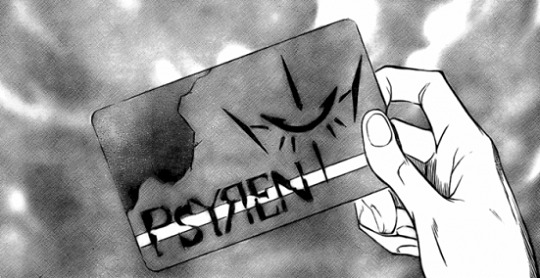
The Big Three, i think, were great for different reasons. One Piece had it’s grad ass narrative, one that is still intriguing, if a little bloated, to this day. Naruto had an air of originality with how it demonstrated it’s world. That ninjitsu sh*t allowed for a ton of imaginative abilities an the Jinchuriki was an interesting take on an OP form. BLEACH, for all of my b*tching, maintained the dopest art, even after Kubo gave up and got pretty lazy. Even so, around 2007, the Big Three began to show there age. The title holders were vulnerable and a ton, an absolute slew, of brand new manga came for their throne. Tsugumomo (a personal favorite which I've written about numerous times on this blog), Spice and Wolf, Rosario+Vampire, Maken-Ki, and Deadman Wonderland (another favorite i should probably get around to gushing about) all developing a massive following but, out side of the two i mentioned here the one manga i found myself completely infatuated with was Psyren.

Psyren is everything you could ever want in a Shonen manga. It has fantastic art, an imaginative world, a compelling plot, endearing characters, and one of the best OP form i have ever seen in my entire life. I love this book, man. I don’t want to spoil too much but Psyren follows Ageha Yoshina, your high school protagonist, who stumbles upon a really f*cked world through a calling card game called Psyren. I don’t want to get too deep into the plot, go f*cking read this thing, but, suffice it to say, that narrative is all over the place. This thing takes you on a ride. There are absolutely great supporting characters and timey-wimey shenanigans all over the place. Ageha is every bit the protagonist that Luffy, Ichigo, or Naruto are and he could, arguably, hold his own with any one of them in a fight. Dude’s ability, however, is probably the most spectacular, outside of Ichigo’s Mugestsu. Seriously, the visual aspect of this book is f*cking stunning. Toshiaki Iwashiro‘s art could give Kubo’s a run for his money, especially toward the end. Not just in aesthetic, but in kineticism and power. Some of these battle scenes were exceptional. That climax where we see Ageha lose his sh*t? Yea, that would have been fantastic to see on onscreen, which brings me to the biggest issue i have with Psyren; Where the f*ck is my anime adaption man??

Psyren had a finite run. There was beginning, middle, and end. Iwashiro had a story he wanted to tell and he told it. Admittedly, it feels a bit rushed toward the end but i think that may have had more to do with Jump and their shenanigans than anything else. Jump relies too much on popularity polls and sh*t so when the audience looks to be waning in interest, sh*t gets the axe. In Psyren’s case, i don’t think that would have been the case if there was an adaption airing weekly. Psyren lends itself to animation, man. It’s glorious to look at and a lot of the battles, if animated with care, could have been truly brilliant to see. Instead, Psyren got the axe and, a decade later, still no anime in sight. It’s mad frustrating because all of those other 2007 manga i listed, they all got to see the small screen. Arguably the best out of all of them? Not even a hint. Missed opportunity, for sure. Even without an onscreen adaption, Psyren still kills. It’s an excellent story full of great art and dope characters. It’s truly a hidden gem and, if you got the time, i suggest checking it out. It deserves way more yes on it and this is me driving that traffic. Go read Psyren and tell people how dope it is. Sh*t deserves all of the shine!

4 notes
·
View notes
Text
So I tried out Summoner Weiss myself and watched others use her and I have to say...
I would rather use Sun over her, as she’s essentially a worse Sun clone. Her Armas Gigas doesn’t live long or do anything worthwhile, and she can’t do good enough damage to help her summon. The only plus side is that Weiss can attack airborne units, but her low HP and weak attack causes her to rely very heavily on her allies.
Sorry Weiss, but the Monkey King reigns supreme on this one.

8 notes
·
View notes
Text
Living Vicariously Through the Naga:The Enigma Lives On in Siem Reap…
by: Genie
Ensconced in the rainforest and steeped in centennial mythology, lies the province of Siem Reap, home to the variegated archaeological extravaganza embodied by Angkor, the old seat of the Khmer Empire. Once shrouded in mystery, this verdant area is dotted far and wide with architectural wonders, however a particular quartet of magisterial temple complexes, open to the public today, accounts for much of its widely deserved mystique: Angkor Wat, Angkor Thom, Preah Khan and Ta Prohm.

The historical promenade through Cambodian history could not begin at a better place than Angkor Wat. After a brisk, vertiginous walk over the frontal moats and their tall lily pads by way of the “floating” bridges, Angkor Wat starts etching its “mountainous”, verdigris contours on the horizon, in all its pomp and pageantry. Some tall palm trees here and there, wandering rhesus monkeys, endless meters of loggias reflecting over the water, and monks clad in orange walking back and forth, act as merely the castellated gateway and battlements to King Suryavarman II’s main, multi-story building and its five signature turrets set against a perennial twilight sparkle.

Given the magnitude of this World Heritage structure, it would take more than one afternoon to visit it properly. Suffice it to say, to this day Angkor Wat is the largest standing religious building in the world. Still and all, its essence is to be found primarily in a threefold enigma. First of all, it is per se rather puzzling that Angkor Wat should be originally consecrated to none other than the Hindu divinity Vishnu. Today, Angkor Wat is both Hindu and Buddhist, but considering that Hinduism is not as geographically widespread as Buddhism from India eastwards and that it is an older religious philosophy, it begs a more in-depth question as to what exactly happened. Hence, the (originally and equally) Hindu Ko Samut Teuk Dos legend, also known as Samudra manthan (in Hindi); in other words, The Churning of the Ocean of Milk.
According to this founding epic, Devas (Gods) and Asuras (Demons) were forever at war to dominate the world. Ever more tired and running out of strength, the Devas asked Vishnu for help. As a token for his help, Vishnu asked the Devas to search for Amrita, the Sacred Elixir of Immortality, from the depths of the cosmos. However, because the task was so difficult, the Devas were forced to ally with their antagonists, the power-voracious Asuras. Using Mount Meru as the pivotal point and the King of the Nagas (snakes), Vasuki, as a churning device, both factions placed themselves at different extremities of the Naga and started pulling, while many treasures emerged from the Ocean of Milk. In time, the Asuras, being closer to the head of the Naga, were eventually poisoned by the fumes it exhaled, only managing to save themselves when Amrita was delivered to them by a divinity emerging from the Ocean of Milk. This episode did not go unnoticed by the Devas; they promptly informed Vishnu, who managed, in turn, to steal back Amrita and hand it to the Devas, so that they could reign supreme and banish the Asuras to hell.

This legendary tale represents the second enigma of Angkor Wat, and is virtually “unlocked” in the impossibly beautiful bas-reliefs stretching along the 49 meters of the east gallery, a grand spectacle where what could have been remnants of muted pink, ochre, and terra-cotta hues can still be slightly discerned by the naked eye between carvings. Also unlocked within Angkor Wat is the third enigma, whereby a Naga princess wed the First King of Ancient Cambodia, giving rise to the Cambodian people or Khmer. In this respect, Angkor Wat has various massive balustrades in the shape of the seven-headed Naga, each head representing the seven “races” of the Naga people. A recurring theme in the Angkorian temples, the seven-headed Naga is part and parcel of Khmer cosmology, as are the Apsaras, the celestial dancing creatures whose main purview included entertaining royalty and divinities on earth with their perfunctory expressions.
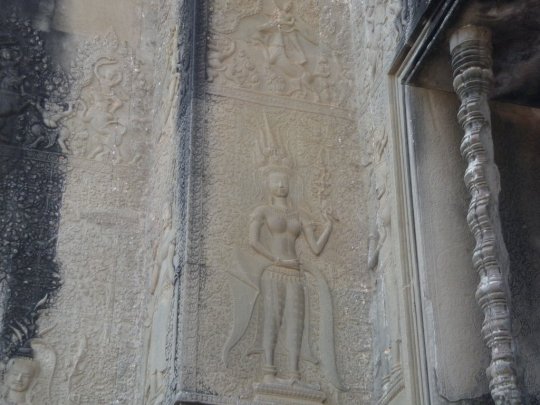
The hypnotic tour through Khmer chronology continues between Angkor Wat and Angkor Thom, where a short pit-stop to the Baksei Chamkrong temple gives us a taste of what would seem to be yet another enigma. According to various “conspiracy” theories, there are uncanny stylistic similarities between the Mayan Pyramid of the Great Jaguar (in Tikal, Guatemala) and Baksei Chamkrong! Clearly, the knowledge and discoveries acquired thus far on the matter are not enough to reframe history, so to say; nonetheless this testament to the universal aspect of human imagination makes for some quite fascinating journeys!
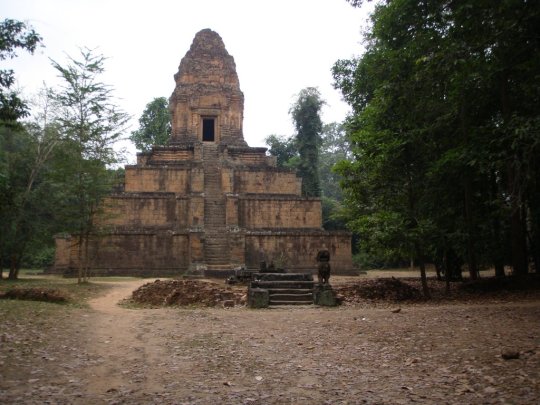
On its part, Angkor Thom, the last capital city of the Khmer Empire, boasts a masterpiece triad of its own, the first of such being King Jayavarman VII’s exquisite 350-meter long Terrace of the Elephants. Once a royal platform to salute his military forces, this terrace features intricate carvings of lions, elephants and Garudas, the bird-like creatures pertaining to Hindu, Buddhist and Jain mythology, and stalwart nemesis of the Nagas. Located just off the Royal Square is the Terrace of the Leper King. Although there was a king with leprosy in Cambodian history, the name derives mainly from the erosion found on the statue of Yama, the God of the Underworld, carved within this site. This terrace might have been used for funerary/cremation rites.
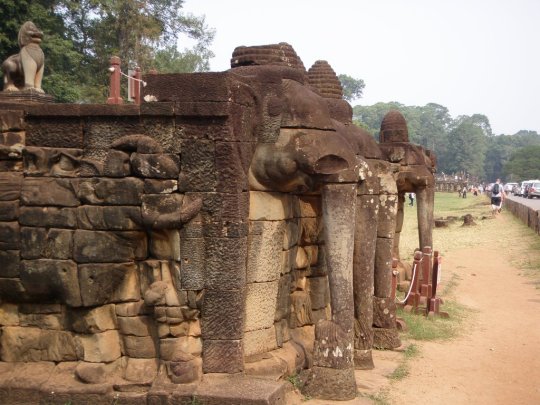
Perhaps the most distinctive temple in Angkor Thom is the “baroque” Prasat Bayon. Entering through the South Gate, one is confronted with nothing short of yet another enigmatic vision, as 200 towering giant faces (four per tower) look down on you with their seraphic smiles and sphinx-like countenances. Although it is unclear whether the faces depict Lokesvara (the Buddhist bodhisattva of compassion) or King Jayavarman VII, the two hypotheses do not necessarily exclude each other. While the bas-reliefs within the temple, portraying military scenes and other mundane events, are also worthy of note, the deeply rooted “intimidation/awe” deriving from the “scoping stares” remains the main highlight of the Bayon. For all we know, they might have been –and still are- quite a bulwark against the evil eye, if anything!
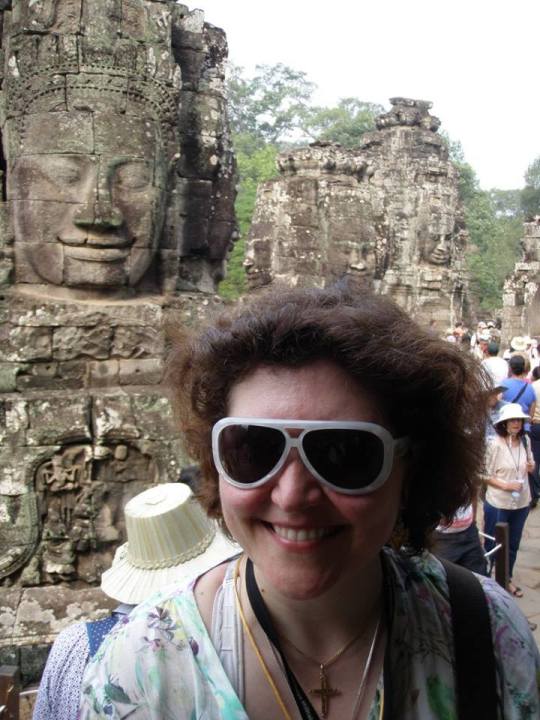
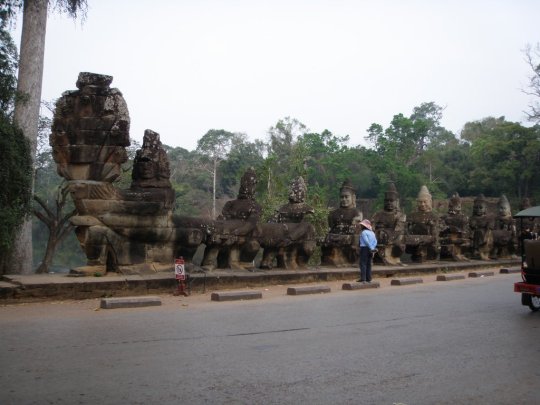

The eternal voyage of the Naga continues in the Neak Pean and Preah Khan temples, located north of Angkor Thom. Upon first impressions, and having to cross a long walkway on swampy waters before reaching the former, it is hard to believe that there might be a temple at the end of the glittering trail. However, Neak Pean juts out from a central sacred pool (believed to represent the mythical Lake Anavatapta and to have healing powers), surrounded by two “underwater” sculptures of the Naga. As regards the latter temple, it is the proof that nature (usually) claims –or ravages, in this case- back its own! At any rate, not even this inevitable and “vengeful” predicament has managed to cover up the ineffable magic of Preah Khan, home to Jayadevi (a sister-wife of King Jayavarman VII), among others. Moss, lychen and ferns slowly brush over the rubble and rickety beams framed by quasi-trompe l’oeil flourishes, while a vast array of delicate carvings, reliefs and friezes, not to mention the standing library ruins and stupa illuminated by the sun, complete this eerie, albeit paradoxically idyllic, setting on the green.



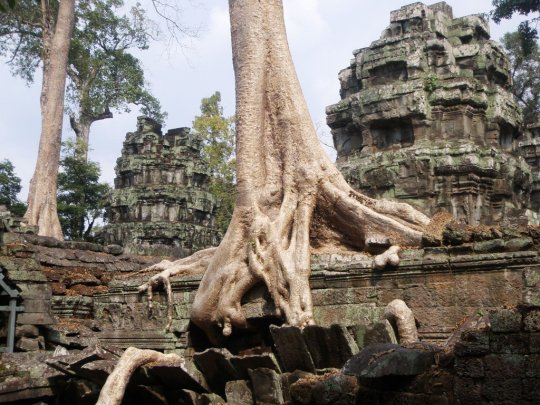
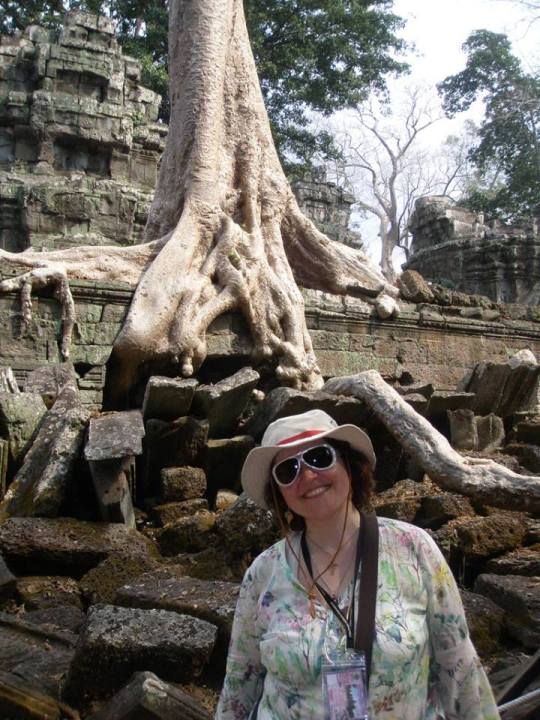
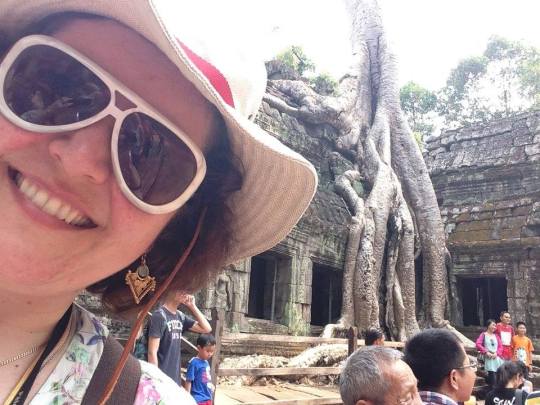
The encroaching nature and weathered look of Preah Khan, however, is solely a prologue to the real devouring power of the forest subsequently witnessed at Ta Prohm, the culminating phase of this open-air museum survey. As soon as Ta Prohm’s ruins are approached, the elusive footpaths give way to a stunning portrait of luxuriant foliage and creeping vines that lift as if they were deep-green shutters following each occasional waft of wind. Here, the Nagas and Apsaras have relinquished their leading roles to the true main protagonists, tetramelacea (tetrameles nudiflora), ficus strangulosa and ceiba pentandra (kapok), names that, given their peculiarity, would seem those of gods, but actually refer to gigantic trees. Their imposing barks have literally taken over the temple complex, coiling up the ruins like the Nagas themselves… or is it that the trees are living vicariously through the Nagas and viceversa? Alas, not even Lara Croft could have possibly deciphered this last enigma, bound to live on for the centuries to come! But, like Lara Croft’s alter-ego, we shall return…
Rome, 5 March 2019
#cambodia#viaggidellelefante#khmerempire#khmertemple#siemreap#angkor#angkorwat#angkorthom#baksei chamkrong#neak pean#prasat bayon#preah khan#ta prohm#apsara#naga#vasuki#samudra manthan#lara croft#tombraider#tomb raider#kapok#tetramelacea#suryavarman#jayavarman#jayadevi#anavatapta#terrace of the elephants#terrace of the leper king#garuda#hindu
12 notes
·
View notes